Chaenactis thompsonii
Chaenactis evermannii
Thompson's pincushion
Evermann's pincushion
mostly 5–15+, ascending to erect.
mostly 5–20+, ascending to erect.
mostly cauline, 2–5 cm;
largest blades ± elliptic, ± plane, 1-pinnately lobed;
lobes mostly 2–5 pairs, remote, ± plane.
basal, 1–5 cm;
largest blades broadly ± elliptic, ± plane, 1-pinnately lobed;
lobes 2–5 pairs, remote, ± plane.
ascending to erect, 2–5 cm.
mostly ascending to erect, 5–10 cm.
± obconic.
± obconic.
7–9 mm.
5–6.5 mm.
longest (10–)12–15 mm;
outer closely lanuginose, not stipitate-glandular, apices erect, ± rigid.
longest 8–12 mm;
outer predominantly closely lanuginose, sparsely, if at all, stipitate-glandular, apices erect, ± rigid.
mostly 1–3 per stem.
1(–3) per stem.
7–9 mm (eglandular);
pappi: longest scales 3.5–5 mm.
5–6.5 mm (eglandular);
pappi: longest scales 2.5–4.5 mm (lengths 0.4–0.8 times corollas).
= 12.
Chaenactis thompsonii
Chaenactis evermannii
Of conservation concern.
Chaenactis thompsonii appears to be sister to C. evermannii; it is known from the mountains of central and northwestern Washington. The similar habits of C. thompsonii and C. ramosa (= C. douglasii var. douglasii) appear to result from convergent evolution in the distinctive habitat of their type localities (Wenatchee Mountains), not from a close genetic relationship as suggested by Cronquist.
(Discussion copyrighted by Flora of North America; reprinted with permission.)
Chaenactis evermannii is known from mountains of central Idaho. Reports of it from Washington and California/Nevada (P. Stockwell 1940, some as C. nevadensis var. mainsiana) were based on specimens of C. thompsonii and C. alpigena, respectively; all three species are closely related.
(Discussion copyrighted by Flora of North America; reprinted with permission.)


